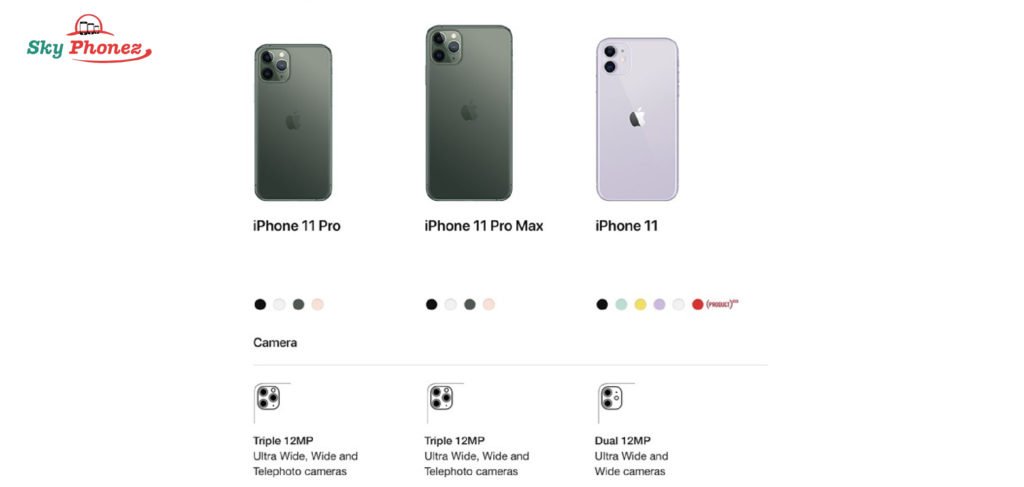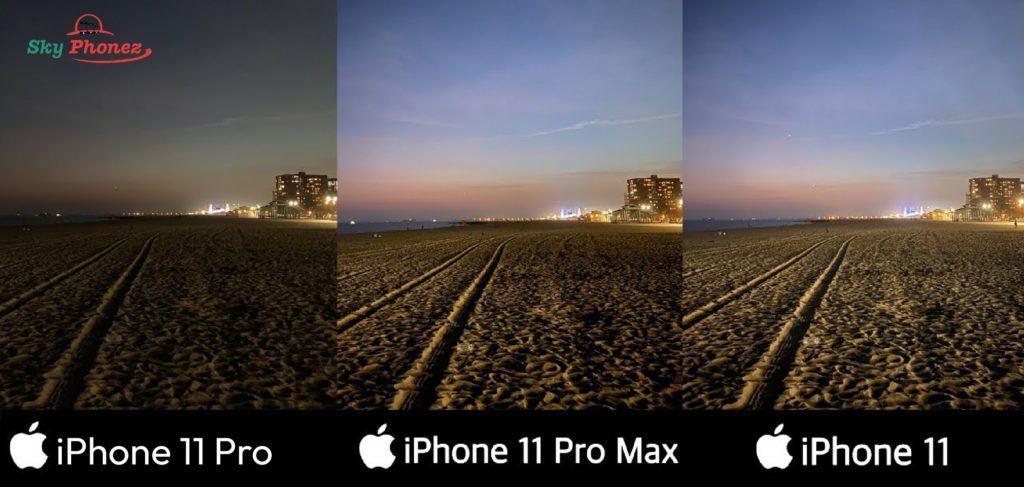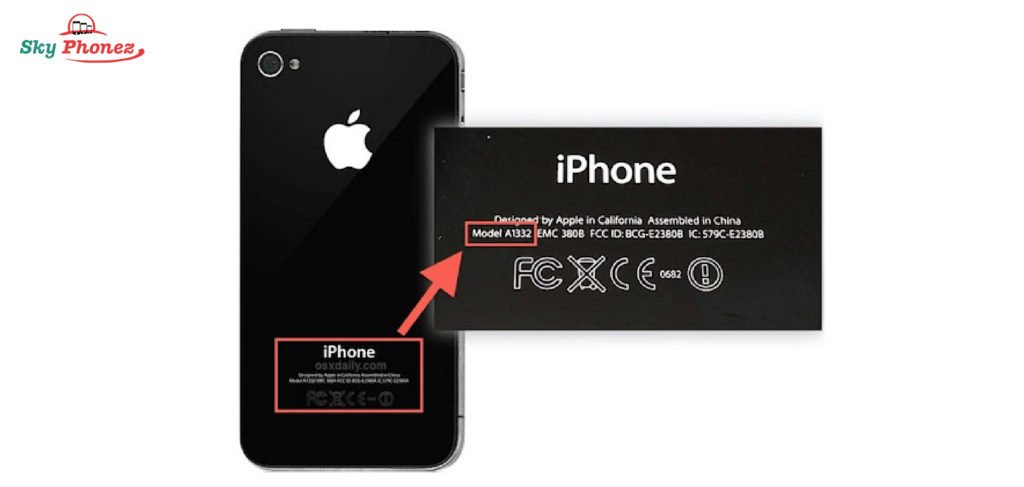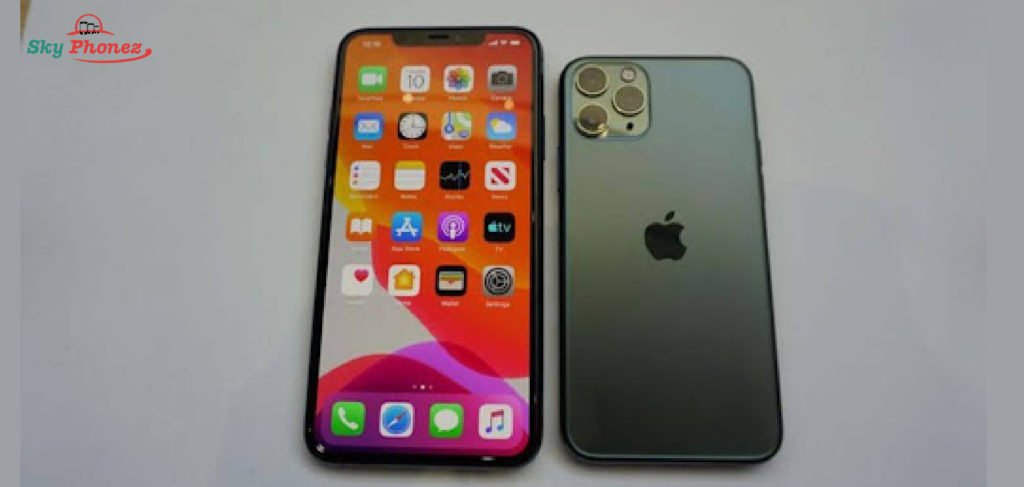Fantastic Discounts On Oppo Products. Apply discount code OPPO20.
Are the iPhone 11 Models Worth It in 2024? Comparing Features and Endurance

The smartphone market has greeted several iPhone families since the iPhone 11 series phones were released back in 2019.
After many years, the iPhone 11 models, which include the iPhone 11, 11 Pro, and 11 Pro Max, still offer some exciting perks for Apple fans.
This blog delves into various aspects of these models, from design and display to camera capabilities, performance, battery life, and overall value.
We’ll explore whether these devices hold their ground in the face of newer models and if they’re worth considering for those on the lookout for a reliable smartphone without breaking the bank.
This will help you make the best decision about whether the iPhone 11 family iPhones are worth your consideration or not.
Ready to learn?
Let’s dive in.
Key Takeaways
- The iPhone 11 Pro’s smaller size offers better ergonomics, while its OLED display outshines the 11’s LCD screen in terms of visual appeal.
- A telephoto lens on the iPhone 11 Pro and Pro Max adds versatility to photography, a feature absent in the standard iPhone 11.
- Despite being older models, the iPhone 11 series maintains commendable performance and battery life, with the Pro Max offering all-day endurance.
- In terms of pricing, the iPhone 11 models present a more affordable option compared to the newer iPhone 12 Pro Max, while still offering robust features.
- Deciding whether to upgrade involves weighing factors such as battery life, where some Android devices may surpass iPhones, and considering the latest technological advancements.
Design and Display: Aesthetic and Visual Comparison
Size and Ergonomics: The Case for Smaller Phones
In the era of ever-growing smartphone screens, the iPhone 11 models offer a refreshing counterbalance with their more manageable sizes. Users have found that the physical dimensions of the iPhone 11 series facilitate easier handling and pocketability, which is a significant factor for those who prefer one-handed use or have smaller hands.
- iPhone 11 Dimensions: Understanding the physical size of your device is crucial for both usage and accessorizing. The iPhone 11’s dimensions are 150.9 x 75.7 x 8.3 mm (5.94 x 2.98 x 0.33 in). These strike a balance between screen real estate and ergonomic comfort, making it a compelling choice for users in 2024.
- The iPhone 11 screen size is 6.1 inches which is a Liquid Retina IPS LCD, the iPhone 11 Pro screen size is 5.8 inches with a Super Retina XDR OLED panel, and the iPhone 11 Pro Max screen size is 6.5-inch with the Super Retina XDR OLED technology.
- The iPhone 11 weight is 194 g, the iPhone 11 Pro weight is 188 g, and the iPhone 11 Pro Max weight is 226 g.
While larger screens are often equated with a better viewing experience, the iPhone 11 models remind us that comfort and ease of use are equally important. The design choices made by Apple have ensured that these models remain relevant and desirable, even as newer, larger phones enter the market.
Despite the allure of bigger displays, the iPhone 11’s design has stood the test of time, proving that a well-thought-out ergonomic approach can have lasting appeal.
Screen Quality: OLED vs. LCD

When it comes to screen quality, the iPhone 11 models present a significant choice between the traditional LCD technology and the more advanced OLED displays. The Super Retina and Super Retina XDR displays, featured in the higher-end models, offer a leap in visual experience. These displays are known for their high brightness and wide colour support, which are crucial for a more vibrant and dynamic viewing experience.
The differences between OLED and LCD screens are not just about brightness and colour, but also about the black levels and contrast ratio. OLED displays can turn off pixels completely to achieve true black, enhancing the overall contrast. This is something LCD screens simply cannot match.
While LCD screens have served us well for many years, the move towards OLED technology in smartphones represents a shift towards better efficiency and visual fidelity.
Here’s a quick comparison of the two technologies:
- OLED: True blacks, higher contrast ratio, more power-efficient when displaying dark content.
- LCD: Generally cheaper, longer lifespan, but lacks the deep black levels of OLED.
In conclusion, if screen quality is a top priority for you, the OLED-equipped iPhone models are likely to be more appealing. However, if you’re looking for longevity and cost-effectiveness, the LCD models might still hold their ground in 2024.
Durability: Assessing Cracked Screens and Waterproofing
When considering the durability of iPhone 11 models in 2024, two critical factors come to the forefront: screen integrity and water resistance. The iPhone 11 series boasts impressive durability, but as time passes, the likelihood of encountering a cracked screen increases. Users should note that while the front glass is designed to withstand everyday drops and scratches, the cost of replacement can still be significant if damage occurs.
Waterproofing is another vital aspect of the iPhone 11’s endurance. Originally rated for IP68 water and dust resistance, these models can theoretically handle submersion in up to 2 meters of water for 30 minutes. However, seals and waterproofing can degrade over time, so it’s essential to consider this when exposing the device to water years after purchase.
Despite the robust build, users should exercise caution with older devices as wear and tear can compromise their original resistance capabilities.
Here’s a quick overview of the durability features of the iPhone 11 models:
- Front glass: Dual-ion exchange process for increased strength
- Water resistance: IP68 rating (up to 2 meters for 30 minutes)
- Dust resistance: IP68 rating ensures protection against harmful dust ingress
Ultimately, while the iPhone 11 models remain relatively sturdy, the passage of time may necessitate additional protective measures, such as cases or screen protectors, to maintain their resilience.
Camera Capabilities: Beyond Megapixels

The Advantage of the Telephoto Lens
The telephoto lens in the iPhone 11 Pro Max has been a game-changer for mobile photography, offering a 12-megapixel sensor and the ability to achieve 2x optical zoom without compromising image quality. This feature significantly enhances depth of field and portrait photography, providing users with the flexibility to capture distant subjects with clarity.
The iPhone 11 Pro Max’s telephoto lens fuels stunning photography that rivals professional cameras, making it a compelling feature for photography enthusiasts.
However, when compared to the newer iPhone 12 Pro Max, the telephoto lens sees considerable improvements. The iPhone 12 Pro Max’s lens offers a 65 mm focal length and leverages sensor-shift optical image stabilization, which is particularly beneficial in low-light conditions. The addition of Apple ProRAW gives photographers unprecedented control over their images, further elevating the iPhone’s camera capabilities.
| Feature | iPhone 11 Pro Max | iPhone 12 Pro Max |
| Telephoto Lens | 12 MP, 2x Optical Zoom | 12 MP, 2.5x Optical Zoom |
| Focal Length | 52 mm | 65 mm |
| Image Stabilization | Optical | Sensor-shift |
| Low-light Performance | Night mode | Night mode, Larger Sensor |
While the iPhone 11 Pro Max remains a strong contender in mobile photography, the advancements in the iPhone 12 Pro Max’s telephoto lens and camera system as a whole suggest a significant leap forward for those prioritizing camera performance.
Comparing Photo Quality Across the Models
When assessing the photo quality of iPhone 11 models in 2024, it’s clear that Apple’s commitment to advanced computational photography has paid dividends. Features like Smart HDR 3 and Deep Fusion have been game-changers, optimizing image processing for remarkable results. Yet, the iPhone 12 Pro Max has raised the bar with Dolby Vision HDR recording, offering users the ability to capture videos with unprecedented clarity and colour accuracy.
The iPhone 12 Pro Max’s larger sensor and sensor-shift optical image stabilization marks a significant leap in camera technology, particularly in low-light performance and detailed photography.
Despite these advancements, the iPhone 11 models still hold their ground, especially considering their much lower price as compared to their launch prices. For those debating whether the camera improvements justify an upgrade, here’s a quick comparison:
| Feature | iPhone 11 | iPhone 12 Pro Max |
| Smart HDR | 3 | 3 |
| Deep Fusion | Yes | Yes |
| Dolby Vision HDR | No | Yes |
| Sensor Size | Standard | Larger |
| Optical Image Stabilization | Standard | Sensor-shift |
In conclusion, while newer models like the iPhone 12 Pro Max offer cutting-edge camera features, the iPhone 11’s camera system remains competitive, particularly for users who prioritize value over the latest technology.
Long-Term Camera Performance and Reliability

When considering the long-term performance and reliability of iPhone cameras, the iPhone 11 models have proven to be resilient. Over time, users have experienced consistent camera quality, with minimal degradation in image sharpness or colour accuracy. The advanced camera systems, with their computational photography capabilities, continue to deliver high-quality photos even after years of use.
The iPhone 11’s powerful image signal processor ensures that photography enthusiasts can rely on their device for capturing important moments without a noticeable drop in performance over time.
However, it’s important to note that newer models like the iPhone 12 Pro Max offer significant improvements in sensor technology and features such as Apple ProRAW, which may entice users looking for the cutting edge in mobile photography. Below is a comparison of key camera features that have stood the test of time:
- Computational photography enhancements
- AI-driven features for image optimization
- Advanced image signal processing
- High-quality video recording capabilities
While the iPhone 11 models remain competitive in camera performance, advancements in newer models could be a deciding factor for users with specific photographic needs or those seeking the latest technology.
Performance and Battery Life: Enduring Power

Processor Efficiency: A14 Bionic Chip vs. Older Generations
When it comes to processor efficiency, the A14 Bionic chip represents a significant leap forward from the A13 Bionic found in the iPhone 11 Pro Max. The A14’s architecture is designed for speed and energy efficiency, which translates into smoother performance and longer battery life.
The A14 Bionic chip enhances overall speed and responsiveness, making it ideal for demanding tasks such as video editing and gaming.
Here’s a quick comparison of the two chips:
| Feature | A13 Bionic | A14 Bionic |
| CPU Performance | Fast | Faster |
| GPU Performance | High | Higher |
| Energy Efficiency | Efficient | More Efficient |
| Suitable for | Multitasking | Demanding tasks |
While the A13 Bionic chip in the iPhone 11 Pro Max ensures smooth multitasking and fast app launches, the A14 Bionic chip in the iPhone 12 Pro Max takes these capabilities to the next level with improved power management and overall battery performance.
Battery Endurance: Can You Go All Day?
In the realm of smartphones, battery endurance is a critical factor for users who rely on their devices throughout the day. The iPhone 11 Pro Max and iPhone 12 Pro Max both boast all-day battery life, a feature that has become a cornerstone of Apple’s promise for productivity and connectivity without the anxiety of a midday charge.
While many Android devices offer varying battery capacities, some are known to outlast iPhones, especially with features like fast charging technologies. However, the iPhone 11 models hold their own in this competitive space, providing a balance of efficiency and longevity.
Battery performance is not just about the capacity; it’s also about how the software manages power consumption. Here’s a quick look at how the iPhone 11 models fare in terms of battery life:
- iPhone 11: Up to 17 hours of video playback
- iPhone 11 Pro: Up to 18 hours of video playback
- iPhone 11 Pro Max: Up to 20 hours of video playback
These figures are impressive, but real-world usage can vary. Factors such as screen brightness, app usage, and network conditions can all impact battery life. Users should consider their usage patterns when evaluating the endurance of their devices.
The Impact of Software Updates on Performance
Software updates are a double-edged sword when it comes to performance. On one hand, they bring security patches, new features, and performance improvements. On the other, they can temporarily affect the battery life and overall responsiveness of your iPhone 11. Users often report a slowdown immediately after an update, which is typically due to system indexing and other background tasks.
It’s important to note that any performance dips following an update are usually short-lived. The iPhone is known to recalibrate and return to normal operation within a couple of days.
However, as the iPhone 11 ages, the impact of new iOS versions may become more pronounced. The hardware may struggle to keep up with the demands of newer software, leading to a permanent decrease in performance. To illustrate this, consider the following table showing user feedback on performance post-update:
| iOS Version | User Feedback on Performance |
| iOS 15.6 | Noticeable lag in multitasking |
| iOS 16.3 | Improved camera speed |
| iOS 17.2.1 | Temporary battery impact |
In conclusion, while updates are essential for security and accessing the latest features, they can temporarily disrupt the user experience. It’s advisable to update at a convenient time when you can afford to be without your phone for a little while.
Pricing and Value: What’s the Best Deal in 2024?
Cost-Benefit Analysis: iPhone 11 Models vs. Newer iPhones
In 2024, the iPhone 11 models still present a viable option for users seeking Apple’s quality without the premium price of the latest releases. While the iPhone 11’s A13 Bionic chip may not match the raw power of newer chips, it handles most tasks with ease, maintaining relevance in the current tech landscape.
- Lower cost compared to newer models
- May not be significantly cheaper than newer budget options
However, the price gap between the iPhone 11 and newer budget-friendly iPhones has narrowed, making the decision less straightforward. Prospective buyers must weigh the benefits of the iPhone 11’s proven performance against the allure of newer features at a similar price point.
In assessing the value proposition of the iPhone 11 models, it’s crucial to consider long-term support and the potential cost of ownership, including repairs and battery replacements.
Availability and Price Trends for iPhone 11 Models
As we move further away from their release dates, the iPhone 11 models have seen a predictable decline in prices. Initially, the iPhone 11 started at $699, the iPhone 11 Pro at $999, and the iPhone 11 Pro Max at $1099. Now, in 2024, these models are more accessible to budget-conscious consumers, reflecting the typical depreciation of technology over time.
The iPhone 11 series’ availability remains high, with ample stock found in both physical and online stores. This saturation in the market has contributed to the price reduction, making them an attractive option for those seeking Apple’s quality without the latest model’s price tag.
Here’s a quick look at the current average prices for the iPhone 11 models in March 2024:
| Model | Original Price | March 2024 Price |
| iPhone 11 | $699 | $279 |
| iPhone 11 Pro | $999 | $399 |
| iPhone 11 Pro Max | $1099 | $499 |
These prices are subject to change based on demand, promotions, and the introduction of newer models. However, they offer a snapshot of the value you can expect from the iPhone 11 series today.
Comparing the Resale Value of iPhone 11 Models
When considering the resale value of iPhone 11 models in 2024, it’s important to note that these devices still hold a significant portion of their original value. The average resale price for a used iPhone 11 Pro is currently $239.25. This figure can be increased by comparing trade-in prices, potentially raising the buyback value to $267.00 for the 64GB model.
The resale value of an iPhone is a testament to its enduring quality and the brand’s strong secondary market.
However, several factors influence the resale price, including the phone’s condition, storage capacity, and market demand. Below is a succinct table reflecting the current resale trends for various iPhone 11 models:
| Model | Average Resale Price | Good Condition | Excellent Condition |
| iPhone 11 | $189.00 | $200.00 | $220.00 |
| iPhone 11 Pro | $239.25 | $250.00 | $267.00 |
| iPhone 11 Pro Max | $259.00 | $270.00 | $290.00 |
It’s evident that the iPhone 11 Pro Max commands a higher resale value, which may be attributed to its larger display and more advanced features compared to the standard iPhone 11 and iPhone 11 Pro. As newer models continue to enter the market, these resale prices may fluctuate, but the iPhone 11 series remains a worthwhile investment for those looking to sell their devices.
Final Verdict: To Upgrade or Not to Upgrade?
Comparing iPhone 11 Pro Max and iPhone 12 Pro Max

When it comes to choosing between the iPhone 11 Pro Max and the iPhone 12 Pro Max, potential buyers are often curious about what sets these two models apart. The iPhone 12 Pro Max introduces the A14 Bionic chip, which offers a significant performance boost over the iPhone 11 Pro Max’s A13. Additionally, the 12 Pro Max enhances the camera experience with features like Night mode and Deep Fusion, not to mention its 5G support.
Here’s a quick comparison of key features:
| Feature | iPhone 11 Pro Max | iPhone 12 Pro Max |
| Chip | A13 Bionic | A14 Bionic |
| Camera Enhancements | Standard | Night mode, Deep Fusion |
| Connectivity | 4G LTE | 5G |
Despite the advancements in the iPhone 12 Pro Max, the iPhone 11 Pro Max continues to be a strong contender with its robust performance and high-quality camera system. For many, the decision to upgrade will hinge on whether these enhancements in the iPhone 12 Pro Max align with their specific needs and usage patterns.
In conclusion, while the iPhone 12 Pro Max offers the latest technology, the iPhone 11 Pro Max still holds its ground as a reliable and capable device.
When to Consider Switching to Android for Battery Life
When evaluating smartphones in 2024, battery life emerges as a pivotal factor for many users. Android devices have made significant strides in this area, with some models boasting battery capacities that eclipse those of iPhones. These advancements, coupled with rapid charging technologies like Qualcomm Quick Charge, make Android an attractive option for power users.
Android’s diverse ecosystem offers a range of devices with varying battery performances. In particular, certain Android phones have demonstrated the ability to last for extended periods, outperforming iPhones in endurance tests. This is especially relevant for users who require their phones to hold out for at least 12 hours on a single charge.
While iPhones continue to offer optimized power management and the convenience of wireless charging, the gap in battery longevity between the two ecosystems is narrowing. Users who prioritize battery life above all else may find that switching to an Android device provides the endurance they need without compromising on other features.
Making the Decision: Factors to Consider Before Upgrading
When standing at the crossroads of technology, deciding whether to upgrade your iPhone 11 model can be a complex process. Consider your current device’s performance and how it meets your daily needs. If your iPhone still runs smoothly and efficiently handles your routine tasks, an upgrade might not be necessary.
However, if you’re experiencing sluggishness, frequent app crashes, or battery issues, it may be time to consider the benefits of a newer model. The iPhone 12 Pro Max, for instance, offers significant improvements in areas like 5G support and camera technology.
Upgrading is not just about getting the latest device; it’s about ensuring your technology aligns with your lifestyle and requirements.
Before making a decision, review the following points:
- Assess your current device’s performance and battery life.
- Evaluate the new features and technologies of the latest models.
- Consider the financial implications, including the potential resale value of your current iPhone.
- Reflect on your brand loyalty and whether an alternative operating system could better serve your needs.
Conclusion
The iPhone 11 models, including the 11, 11 Pro, and 11 Pro Max, continue to hold their ground in 2024. With their varying sizes, the Pro models’ telephoto camera, and the OLED display on the 11 Pro, they cater to different preferences and needs. Durability tests have shown that these devices can withstand the test of time, and their performance remains competitive, especially when considering the price point relative to newer models. For those not requiring the absolute latest in Apple technology, the iPhone 11 series offers a compelling blend of features, quality, and value. Whether it’s the hand-friendly size of the 11 Pro, the endurance of the 11 Pro Max, or the balance of features and cost in the iPhone 11, these models are still worth considering in 2024.
Frequently Asked Questions
Are the iPhone 11 models still a good choice in 2024?
Yes, the iPhone 11 models remain a viable option in 2024, offering solid performance, good camera capabilities, and durability, especially for those who prefer smaller phones and are looking for a more affordable alternative to the latest iPhones.
What are the key differences between the iPhone 11 and iPhone 11 Pro displays?
The iPhone 11 features a 6.1-inch LCD display, while the iPhone 11 Pro has a smaller 5.8-inch OLED screen, which provides better contrast and true blacks. The choice between the two would depend on personal preference for screen size and quality.
How does the telephoto lens on the iPhone 11 Pro models enhance photography?
The telephoto lens on the iPhone 11 Pro and Pro Max allows for better zoom capabilities and portrait mode shots, offering greater versatility and higher quality images when compared to the iPhone 11’s dual-camera setup.
Can the iPhone 11 Pro Max’s battery life compete with newer models?
The iPhone 11 Pro Max offers all-day battery life, which is competitive with newer models. The efficiency of the A13 Bionic chip, along with optimized power management, ensures enduring performance throughout the day.
Is there a significant price difference between the iPhone 11 Pro Max and the iPhone 12 Pro Max?
Yes, as the iPhone 11 Pro Max is an older model, it is generally available at a lower price point than the iPhone 12 Pro Max, which offers newer features and technologies at a premium price.
When should I consider upgrading from an iPhone 11 model to a newer iPhone?
Consider upgrading if you require the latest technologies such as 5G support, improved camera systems with features like Apple ProRAW, Dolby Vision HDR recording, or more efficient chips like the A14 Bionic found in the iPhone 12 Pro Max.